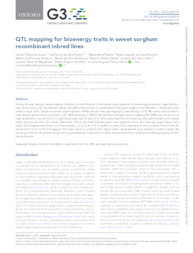QTL mapping for bioenergy traits in sweet sorghum recombinant inbred lines.
QTL mapping for bioenergy traits in sweet sorghum recombinant inbred lines.
Author(s): SOUZA, V. F. de; PEREIRA, G. da S.; PASTINA, M. M.; PARRELLA, R. A. da C.; SIMEONE, M. L. F.; BARROS, B. de A.; NODA, R. W.; SILVA, L. da C. e; MAGALHAES, J. V. de; SCHAFFERT, R. E.; GARCIA, A. A. F.; DAMASCENO, C. M. B.
Summary: During the past decade, sweet sorghum (Sorghum bicolor Moench L.) has shown great potential for bioenergy production, especially biofuels. In this study, 223 recombinant inbred lines (RILs) derived from a cross between two sweet sorghum lines (Brandes Wray) were evaluated in three trials. Single-nucleotide polymorphisms (SNPs) derived from genotyping by sequencing of 272 RILs were used to build a high-density genetic map comprising 3,767 SNPs spanning 1,368.83 cM. Multitrait multiple interval mapping (MT-MIM) was carried out to map quantitative trait loci (QTL) for eight bioenergy traits. A total of 33 QTLs were identified for flowering time, plant height, total soluble solids and sucrose (five QTLs each), fibers (four QTLs), and fresh biomass yield, juice extraction yield, and reducing sugars (three QTLs each). QTL hotspots were found on chromosomes 1, 3, 6, 9, and 10, in addition to other QTLs detected on chromosomes 4 and 8. We observed that 14 out of the 33 mapped QTLs were found in all three trials. Upon further development and validation in other crosses, the results provided by the present study have a great potential to be used in marker-assisted selection in sorghum breeding programs for biofuel production.
Publication year: 2021
Types of publication: Journal article
Unit: Embrapa Maize & Sorghum
Observation
Some of Embrapa's publications are published as ePub files. To read them, use or download one of the following free software options to your computer or mobile device. Android: Google Play Books; IOS: iBooks; Windows and Linux: Calibre.
Access other publications
Access the Agricultural Research Database (BDPA) to consult Embrapa's full library collection and records.
Visit Embrapa Bookstore to purchase books and other publications sold by Embrapa.

